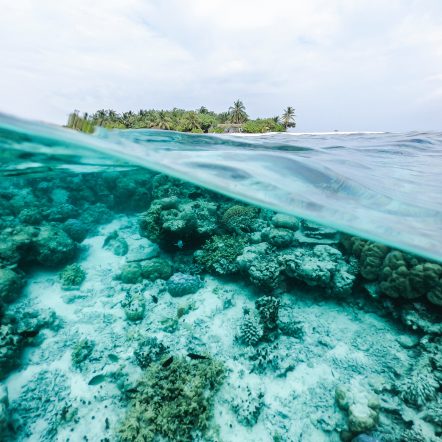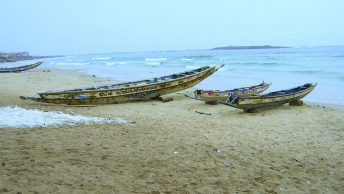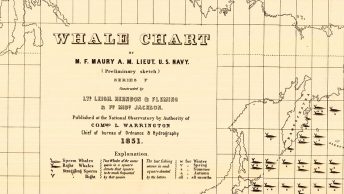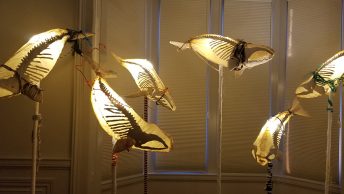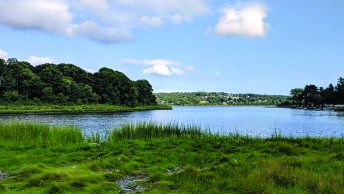Zachary J. Cannizzo, Sara Hutto, and Lauren Wenzel
Abstract
Marine protected areas (MPAs), like their terrestrial counterparts, face a wide range of climate change stressors that challenge traditional management strategies. Ocean acidification, dynamic boundaries, high connectivity, and other complexities create climate management challenges unique to the ocean system. Further, there is a concerning disconnect between global oceanic climate impacts and the relative lack of experience and action needed to address these stressors at local and regional scales. As climate impacts are increasingly being experienced by marine and coastal managers, they are beginning to focus on climate assessment and adaptation within the protected areas of our ocean. In this article, we share case studies and experiences of MPA managers on the cutting edge of climate adaptation. Lessons learned from the kelp forests of California and the coral reefs and seagrass meadows of the Florida Keys highlight hands-on applications of climate management and mitigation. Yet managing for climate change in a dynamic ocean requires more than direct action. We highlight the successes achieved through capacity building, community engagement, and partnership development that span geographic, institutional, and community boundaries. The dynamic nature of climate change in the ocean environment requires MPA managers to be flexible, adaptive, and inclusive to implement successful and meaningful management actions. Ultimately, the experiences highlighted in this article reflect the need for close collaboration with scientists, communities, and diverse stakeholders in identifying and implementing adaptation actions. In doing so, these case studies provide the beginning of a road map for successful climate management in MPAs.
Introduction
Protected areas face a wide range of climate change stressors that challenge traditional management strategies. However, those stressors experienced by marine protected areas (MPAs) often differ in kind or degree from their terrestrial counterparts. MPAs include areas in the ocean designated and managed for long-term conservation, including familiar examples such as national marine sanctuaries, national parks, national wildlife refuges, and the subnational counterparts to these programs. Ocean acidification, warming oceans, changing ocean currents, and marine heat waves are but a few of the climate stressors that make managing for climate change in MPAs fundamentally different from that in the terrestrial realm. These stressors have led to a broad range of devastating impacts, from coral bleaching and the failures of shellfish hatcheries to less-well-known effects such as predictions of failing pteropod (marine zooplankton that are a critical component of anadromous salmonid diets) populations (Bednaršek et al. 2017) and a high rate of species range shifts. The dynamic, highly connected nature of the marine environment and overlapping jurisdictions for different marine activities serve to further exacerbate management challenges.
While MPA managers are largely aware of the unique problems of climate adaptation in the marine environment, there is a concerning disconnect between the scale and effects of oceanic climate impacts and the experience and action needed to address these stressors at local and regional scales. In this regard, the management of terrestrial protected areas is more advanced in both theory and practice. For example, both wildfires and coral bleaching events devastate ecosystems and are exacerbated by climate change. While managers largely understand how to manage and, to an extent, prevent wildfires, there is still some uncertainty as to the main drivers of coral bleaching events (Lapointe et al. 2019) and management actions to prevent bleaching, such as sun shielding and cold-water pumping, are in their infancy. Even within the field of marine climate management, the understanding and study of climate impacts in coastal and near-coastal habitats far outpaces our grasp of the stressors experienced in offshore ecosystems. Further, much of the adaptation work that has been conducted in marine systems has focused on impacts to human communities, with less attention paid to the ecological communities on which these livelihoods often depend. While the focus on impacts that directly affect humans is understandable, it has led to a comparative lack of knowledge that hampers the larger goal of holistic marine climate adaptation.
Fortunately, these knowledge gaps have been identified and MPA managers are beginning to turn their focus to climate assessment and adaptation. Through actions that range from direct management to capacity building, and which involve community engagement and partnership development that spans institutional and geographic boundaries, MPA managers have found success in climate adaptation strategies that are diverse and inclusive. As managers of both terrestrial and marine protected areas grapple with the challenges of climate change, the experiences of MPA managers at the cutting edge of climate adaptation can provide insight into approaches to climate management in a dynamic, rapidly changing environment. Here, we present and discuss two case studies that exemplify the inclusive and flexible adaptation strategies necessary to successfully manage protected areas and resources in the changing ocean. We also highlight partnership development and capacity-building initiatives that have brought success to adaptation efforts.
Case study: Greater Farallones National Marine Sanctuary
Greater Farallones National Marine Sanctuary (GFNMS), managed by the National Oceanic and Atmospheric Administration (NOAA) Office of National Marine Sanctuaries (ONMS), protects 3,295 mi2 of ocean along the north-central California coast from just north of San Francisco to Point Arena (Figure 1). GFNMS is a globally significant, extraordinarily diverse, and productive marine ecosystem that supports abundant wildlife and valuable fisheries. It provides breeding and feeding grounds for at least 25 endangered or threatened species; 36 marine mammal species; over a quarter-million breeding seabirds; and one of the most significant white shark populations on the planet. Like many MPAs around the world, the resources protected by GFNMS are experiencing the pressures of climate change. GFNMS has taken the challenge head-on, establishing an Ocean Climate Program in 2008.
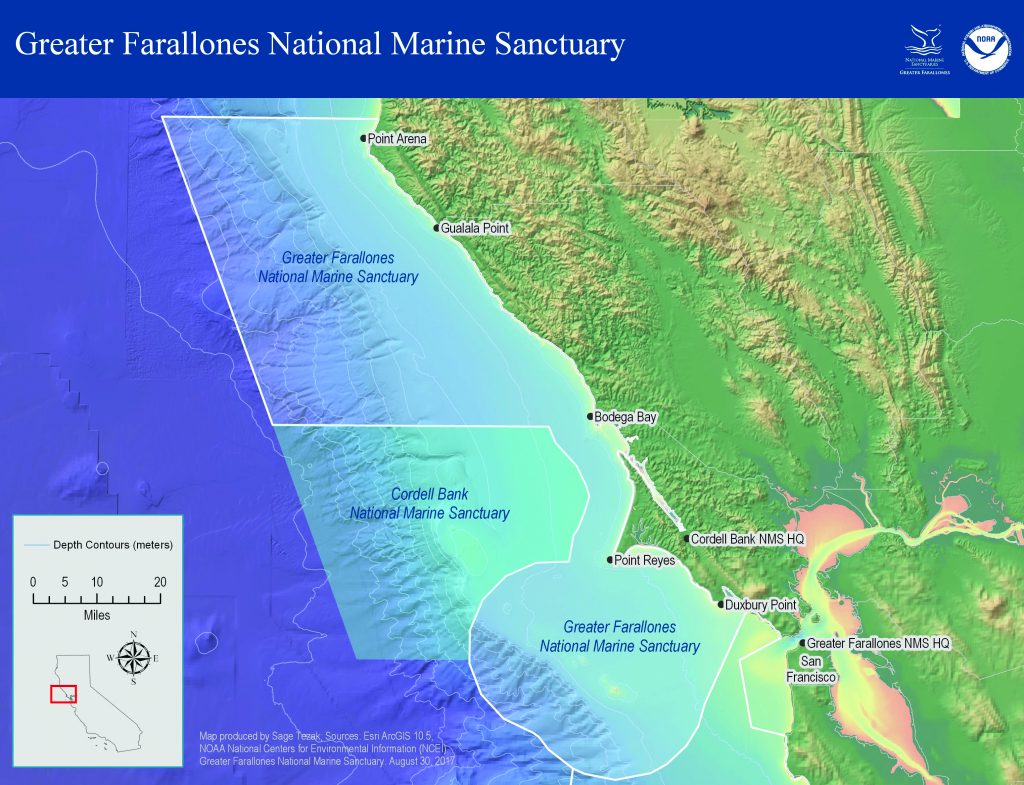
A critical first step in managing a protected area for climate change is to thoroughly evaluate the climate vulnerability of its resources. In 2014, GFNMS became the first marine sanctuary in the US to conduct a climate vulnerability assessment (CVA). CVAs are detailed, science-based efforts to identify why and how focal resources are likely to be affected by future climate conditions. They prioritize targets and focal resources for management, and ultimately help to develop management strategies. The GFNMS CVA was a multi-year process that engaged regional experts from resource management agencies, academic institutions, and nongovernmental conservation organizations to evaluate the vulnerability of 44 focal resources (species, habitats, and ecosystem services) to a number of climate change stressors. Over two workshops, participants drew on their expertise and the scientific literature to evaluate the exposure, sensitivity, adaptive capacity, and overall climate vulnerability of each resource. This resulted in a thorough and transparent report (Hutto et al. 2015), which highlighted the results of the assessment. In 2016, another group of regional experts worked with the sanctuary to use the results of the CVA to develop climate adaptation recommendations for natural resource managers in the region, 26 of which were applicable to the sanctuary and included in a Climate Adaptation Plan (Hutto 2016). This plan has since guided the sanctuary’s management priorities and actions. The success of the GFNMS CVA in helping managers to identify and establish management priorities has set the standard for climate assessment in ONMS and serves as an example of the power of deliberative adaptation planning and assessment.
One habitat that was not identified as particularly vulnerable in the GFNMS CVA was kelp forests. This vibrant habitat is a foundation of the California coast ecosystem and provides habitat to hundreds of ecologically and economically important species, including sea otters and abalone. Kelp forests are also home to protected species of high management priority, such as the critically endangered white abalone (Haliotis sorenseni) in southern California, and the critically endangered black abalone (Haliotis cracherodii) in north-central California and GFNMS. Further, like trees in terrestrial forests, kelp may play a role in climate mitigation. There is some evidence that kelp are globally significant to carbon sequestration (Krause-Jensen and Duarte 2016). Kelp may even locally alleviate ocean acidification (Nielson et al. 2018). Thus, the assessment of moderate-to-low vulnerability for this important habitat was encouraging.
Unfortunately, despite basing the assessment on the best available science, the impacts of climate change are often unpredictable. Between 2012 and 2016, up to 90% of the kelp canopy biomass on the north-central California coast was lost (Figure 2). This loss has had devastating impacts on the ecology and economy of the region, including the crash of the commercial red sea urchin (Mesocentrotus franciscanus) fishery and the closure of the $44 million recreational red abalone (Haliotis rufescens) fishery (Reid et al. 2016). The reduction of kelp cover is likely a result of many interacting factors that persisted over many years. Persistent high water temperatures both directly impacted kelp and fueled a damaging harmful algal bloom. The warm water is also suspected of increasing the virulence of sea star wasting disease (Eisenlord et al. 2016). The subsequent reduction in sea stars, which prey on sea urchins, allowed for a population explosion of the purple urchin (Strongylocentrotus purpuratus), which both overgrazed kelp beds and hindered kelp recovery. This unexpected cascade of interactions between a climate stressor and ecological factors serves as a lesson to managers in all environments: we should expect to be surprised by climate impacts. Even careful assessment of climate vulnerabilities and threats, the most cutting-edge science, and the best ecological models cannot always prepare managers for the unexpected effects of climate change.

Figure 2. Comparison of healthy (2012) and degraded (2016) kelp canopy at Ocean Cove within Greater Farallones National Marine Sanctuary. Photos courtesy of K. Joe, C. Catton, and the California Department of Fish and Wildlife.
The best strategy to address climate surprises is to be prepared to adapt when they occur. The integration of climate change considerations into the overall management of GFNMS has allowed the sanctuary staff to quickly adapt their management strategies to address the problem of kelp loss. In response to recommendations from the GFNMS’s Advisory Council, the sanctuary’s nonprofit partner Greater Farallones Association (GFA) has developed, and begun to implement, a Sonoma–Mendocino Bull Kelp Recovery Plan in partnership with GFNMS and the California Department of Fish and Wildlife (Hohman et al. 2019). The plan is a comprehensive recommendation of detailed strategies spanning monitoring and research, restoration, and community engagement, as well as a list of actions to be pursued both immediately and in the long term. Many of these actions have been or are being implemented with positive results. One of the most direct actions has been to remove purple urchins from a few targeted coves in order to relieve grazing pressure and allow kelp to recover in those areas. This effort has required enhanced collaboration with traditional partners, such as the California Department of Fish and Wildlife, as well as new partnerships with local fishing communities and fishing advocacy groups. Addressing the purple urchin problem also requires innovative solutions. Towards this end, GFA is working with academic institutions, nonprofits, and a for-profit company, Urchinomics, in an attempt to develop a commercial market for purple urchin roe. These strong partnerships of fishermen, regulators, and for-profit companies are supported by the extensive community outreach and capacity building undertaken by the sanctuary as part of its climate change adaptation strategy. Ultimately, GFNMS and GFA are an example of how careful, thorough analysis and planning involving diverse stakeholders and expertise can produce a robust and flexible adaptation strategy, even in the face of climate surprises.
Case study: Florida Keys National Marine Sanctuary
Florida Keys National Marine Sanctuary (FKNMS) protects 3,800 mi2 s of ocean centered around the Florida Keys (Figure 3). The sanctuary is home to hundreds of ecologically, culturally, and economically important resources, including manatees, sea turtles, spiny lobster, and many recreationally and commercially important fishes. FKNMS also protects ecosystems such as coral reefs, mangrove forests, and seagrass meadows, which are all of critical ecological importance and have been degraded by over a century of human impacts, coupled more recently with climate impacts. Coral bleaching, ocean acidification, increased intensity of tropical storms, and sea-level rise are just a few of the effects of climate change impacting these critical ecosystems.
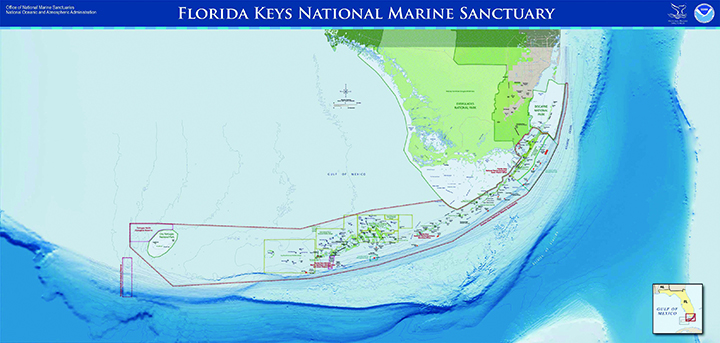
One of the ways that FKNMS is addressing the impacts of climate change is to increase the resilience of critical ecosystems through restoration and the reduction of nonclimate stressors. Released in August 2019, the Florida Keys National Marine Sanctuary Restoration Blueprint draws on 30 years of cutting-edge restoration science, technological experience, and community involvement (NOAA ONMS 2019). The blueprint represents a science-based plan that considers the impacts of climate change while seeking to address the cumulative effects from a wide range of stressors. While there are many actions included in the blueprint, the restoration of key habitats is a strategy that is woven throughout the document.
Coral reefs are the habitat that is perhaps most central to the ecology, economy, and culture of the Florida Keys. The coral reefs of the Florida Keys provide habitat for thousands of species of fish and invertebrates and support $2.1 billion in spending within Monroe County annually. However, coral reefs in FKNMS have been degraded by both human and climate impacts. While past impacts involved activities such as destructive fishing, overharvesting, and excessive nutrient loading, climate effects are increasingly threatening reefs. Ocean acidification and intense storms damage corals, while increasing temperatures lead to expansive coral bleaching. Further, for causes that are not fully understood, stony coral tissue loss disease is sweeping through the Florida reef tract. First appearing near Miami in 2014, it has since spread through most of the Florida reef tract, causing devastating mass coral mortality. It may be worsened by increasing temperatures and nitrification. The combination of human impacts, climate change, and disease have resulted in the loss of much of the coral cover in the Florida Keys.
Managers at FKNMS have taken direct and rapid action to address these threats. Specifically, the restoration blueprint (which is also the draft environmental impact statement for the update of the sanctuary management plan) proposes actions to develop a comprehensive sanctuary restoration plan with goals, prioritized needs, site selection criteria, and research priorities. The restoration blueprint will protect coral reefs by focusing NOAA and partner resources on a comprehensive restoration strategy informed by climate science. There is tremendous interest in coral restoration, but managers need practical guidance, such as which species are most resistant to bleaching and the identification of locations that are more likely to promote coral growth and avoid catastrophic damage from storms. NOAA also proposes to expand zones that provide a higher level of protection to coral ecosystems from ship groundings, anchoring, and other human impacts.
Seagrass meadows are another primary target of the restoration blueprint. These meadows are vital habitats for hundreds of species ranging from sea turtles and manatees to economically important fishes. They also provide an important nursery habitat for reef and pelagic species alike while contributing valuable coastal protection. Further, seagrasses are important carbon sequestration habitats and may alleviate local impacts of acidification (Nielson et al. 2018). While FKNMS protects 1.4 million acres of seagrass meadows, much of this habitat has been highly degraded by human and climate stressors. Boat propellers have scoured large regions of seagrass, while reduced freshwater flow and poor water quality from a century of agriculture have killed thousands of acres. Climate change further threatens seagrasses through warming in the short term, and, over a longer period, sea-level rise, which threatens to gradually drown these light-sensitive ecosystems. The science-based, inclusive plan laid out in the restoration blueprint is designed to allow this vital habitat to recover from human impacts, which in turn will facilitate resilience to climate change impacts, allowing seagrasses to persist for decades to come. Actions in the blueprint specifically targeted to promote seagrass restoration include addressing water quality, working with partners to identify and assess factors that affect the vulnerability and resilience of seagrass habitats to existing and emerging threats, and restricting human activities (e.g., motoring and anchoring) in sensitive or highly impacted areas that have been targeted to restore degraded and damaged seagrass habitats (Figure 4). The blueprint would also reduce adverse impacts to seagrasses and other habitats by enhancing emergency response capabilities, improving compliance and enforcement of regulations, and updating the current zoning plan to provide additional protection to seagrass beds from anchoring and boat traffic.

Partnership development and capacity building
The climate change management challenges faced by managers at GFNMS and FKNMS are being addressed through close collaboration with diverse partners. Such partnerships across institutional and geographic boundaries are vital to successful climate adaptation and management within the highly interconnected and vast ocean environment. Agency partnerships are often a necessity for MPA management, due to shared jurisdiction. When managed well, they can also allow for the incorporation of the diverse expertise necessary for successful climate adaptation. A prime example is Papahānaumokuākea Marine National Monument, the largest protected area in the US. This expansive MPA encompasses the islands and waters of the northwestern Hawaiian Islands (Figure 5). Covering 582,578 mi2 and stretching for a distance of 1,350 mi, it encompasses an area larger than all the nation’s national parks combined. Papahānaumokuākea is comanaged by four trustees: NOAA, US Fish and Wildlife Service (USFWS), the state of Hawaii, and the Office of Hawaiian Affairs. This partnership has allowed the managers of Papahānaumokuākea to pull from a breadth of expertise and resources in order to successfully navigate the daunting task of managing one of the largest, most remote MPAs on Earth under a changing climate. For example, a 2019 research cruise in Papahānaumokuākea documented widespread coral damage at French Frigate Shoals, an atoll in the monument, from Hurricane Walaka, a Category 3 storm that passed through the area in October 2018. That year was the most intense Pacific hurricane season on record, part of a pattern of more intense storms due to warmer oceans. The ability for Papahānaumokuākea managers to leverage a range of expertise and resources allows for the flexibility needed to adapt to this and other climate stressors now and in the future.
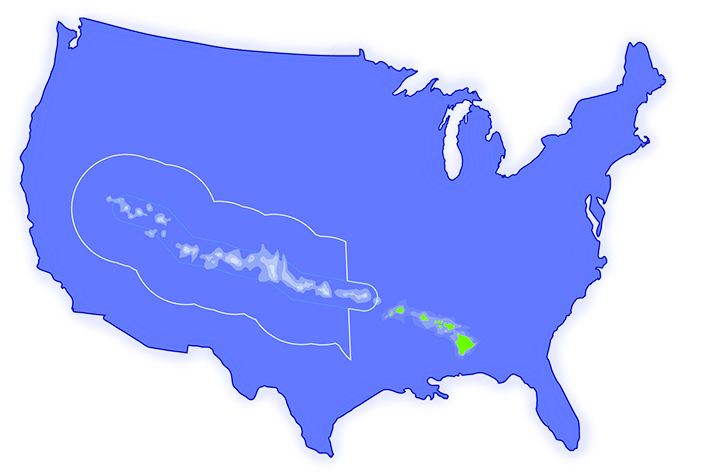
The National Estuarine Research Reserve (NERR) System is another example of successful management through cross-institutional partnerships. The system encompasses 29 estuarine sites jointly managed for research, education, and stewardship by NOAA and the states in which the sites are located. This unique state–federal partnership allows the NERR System to leverage federal funding and guidance while maintaining local management and considerations. Further, many NERRs partner with local universities, allowing them to participate in and leverage the cutting-edge research necessary to manage under climate change. This partnership has been particularly fruitful, as one focus of several sites in the system has been the collaborative study, mapping, and management of “blue carbon” habitats—tidal wetlands, seagrasses, and mangroves—that store vast amounts of carbon. Beyond the breadth of experience that such a diverse partnership can draw upon, this management design has allowed the NERR System to be flexible and adaptive in the face of changes to not only the climate, but also the socioeconomic and political environments.
As climate impacts have become more widely understood over the past decade, government agencies and nongovernmental organizations have been working to develop and deliver training materials focused on climate adaptation strategies for resource managers. Here too, the understanding of the science and tools available to marine managers, and focused training efforts, have lagged behind terrestrial counterparts. However, in 2018 the USFWS National Conservation Training Center (NCTC) began a partnership with NOAA to adapt a core course on climate adaptation—“Planning for a Changing Climate”—into a version with a coastal and marine focus. This new course, which will be taught in different regions of the country each year, is targeted at MPA and fisheries managers and focuses on steps and strategies necessary for effective climate adaptation in a marine environment. Through this course, NCTC and NOAA are both increasing the climate adaptation capacity of MPA and fishery managers and building partnerships among participants at the regional scale.
The interconnectedness and sheer scale of the ocean often translates into a need to develop international partnerships in order to successfully manage MPAs and oceanic resources. NOAA’s National Marine Protected Areas Center facilitates partnerships that have increased the adaptive capacity of MPAs internationally. Serving as a hub for MPA information, tools, and capacity building, the center works with others to build networks of MPA managers to share experience and build expertise. The center’s international capacity building team, known as IMPACT, works closely with the US Agency for International Development to conduct dozens of trainings around the world for MPA managers on building effective MPA networks, including climate assessment and adaptation. In addition to its work through IMPACT, the center also collaborates with the Commission for Environmental Cooperation (CEC), a trilateral partnership between the US, Canada, and Mexico. CEC has greatly advanced cooperation among MPA managers in the three countries, as well as their capacity to address climate impacts. Recent products include a rapid vulnerability assessment (RVA) tool (published in English, Spanish and French), and an MPA adaptation toolkit, both of which are being used by managers to leverage international expertise and insights when managing for climate change.
A more condensed version of the CVA undertaken by GFNMS, an RVA allows managers to identify resources that are most likely to be vulnerable to climate change. RVAs allow managers to obtain information on vulnerable resources by leveraging the input of managers along with scientific experts and other knowledge holders in the community. This inclusion of diverse perspectives during RVA workshops helps build consensus and future partnerships across disciplines, and creates a common understanding of key challenges and potential solutions. In this way, RVAs can serve as a tool for public outreach and inclusivity as well as a powerful tool for planning and management.
Protected area managers have a key role to play in educating the public about climate science and impacts. The National Park Service has played a leading role in interpreting climate impacts on the national park system. MPA programs, such as sanctuaries and NERRs, also have a strong education mission, and have incorporated climate into their outreach and educational programs and materials. These activities are diverse, ranging from webinars and lectures to classroom visits and art activities. Climate outreach and education do more than just inform: they develop interest that can generate actions to address climate mitigation and adaptation at the community, state, national, and international scales. The careful design of a variety of climate change outreach and education activities has allowed MPA managers to engage diverse communities across the country and around the world.
Building capacity and developing partnerships is something that should begin long before climate adaptation actions are needed. Both GFNMS and FKNMS illustrate the value of involving the community and stakeholders early on and throughout the management process to foster understanding and partnerships while building support for necessary actions. Only through deliberate, inclusive partnership- and capacity-building can MPA managers hope to successfully create the coalition of managers, stakeholders, and the public necessary to implement effective climate change adaptation.
Conclusions
The climate change challenges facing MPAs are daunting. The unique challenges associated with working in the ocean and the dynamic nature of climate change in the marine environment requires managers to be flexible, adaptive, and inclusive to implement effective management techniques. Ultimately, the successful adaptation to climate change in MPAs will hinge on the ability of managers to collaborate closely with scientists, communities, and diverse stakeholders to identify and implement appropriate adaptation strategies. The challenge is enormous and MPA managers largely lag behind their terrestrial counterparts. However, the case studies shared here highlight examples of how MPA managers are working to meet the challenge. By following the lead of MPA managers at the cutting edge of climate change adaptation, we can ensure that our protected areas and resources have the best possible chance to adapt and persist for decades to come.
Zachary J. Cannizzo, National Oceanic and Atmospheric Administration
Sara Hutto, Greater Farallones Association
Lauren Wenzel, National Oceanic and Atmospheric Administration
Corresponding author:
Zachary J. Cannizzo
National Oceanic and Atmospheric Administration
Office of National Marine Sanctuaries
National Marine Protected Areas Center
Silver Spring, MD 20910
zac.cannizzo@noaa.gov
References
Bednaršek, N., R.A. Feely, N. Tolimieri, A.J. Hermann, S.A. Siedlecki, G.G. Walsbusser, P. McElhany, et al. 2017. Exposure history determines pteropod vulnerability to ocean acidification along the US West Coast. Scientific Reports 7(1): 4526.
Eisenlord, Morgan E., Maya L. Groner, Reyn M. Yoshioka, Joel Elliot, Jeffery Maynard, Steven Fradkin, Margaret Turner, et al. 2016. Ochre star mortality during the 2014 wasting disease epizootic: Role of population size structure and temperature. Philosophical Transactions of the Royal Society B: Biological Sciences 371(1689): 20150212.
Hohman, Rietta, Sara V. Hutto, Cynthia Catton, and Francesca Koe. 2019. Sonoma–Mendocino Bull Kelp Recovery Plan. Plan for the Greater Farallones National Marine Sanctuary and the California Department of Fish and Wildlife. San Francisco: Greater Farallones Association.
Hutto, Sara. 2016. Climate Adaptation Plan. Report of the Greater Farallones National Marine Sanctuary. San Francisco: NOAA.
Hutto, Sara V., Kelley D. Higgason, Jessie M. Kershner, Whitney A. Reynier, and Darrell S. Gregg. 2015. Climate Change Vulnerability Assessment for the North-Central California Coast and Ocean. Marine Sanctuaries Conservation Series ONMS-15-02. Silver Spring, MD: US Department of Commerce, National Oceanic and Atmospheric Administration, Office of National Marine Sanctuaries.
Krause-Jensen, Dorte, and Carlos M. Duarte. 2016. Substantial role of macroalgae in marine carbon sequestration. Nature Geoscience 9(10): 737–742.
Lapointe, Brian E., Rachel A. Brewton, Laura W. Herren, James W. Porter, and Chuanmin Hu. 2019. Nitrogen enrichment, altered stoichiometry, and coral reef decline at Looe Key, Florida Keys, USA: A 3-decade study. Marine Biology 166(8): 108.
Nielson, K., J.J. Stachowicz, H. Carter, K. Boyer, M. Bracken, F. Chan, F. Chavez, et al. 2018. Emerging Understanding of the Potential Role of Seagrass and Kelp as an Ocean Acidification Management Tool in California. Oakland, CA: California Ocean Science Trust.
NOAA ONMS [National Oceanic and Atmospheric Administration, Office of National Marine Sanctuaries]. 2019. Draft Environmental Impact Statement for Florida Keys National Marine Sanctuary: A Restoration Blueprint. Silver Spring, MD: U.S. Department of Commerce, NOAA ONMS.
Reid, John, Laura Rogers-Bennett, Felipe Vasquez, Maya Pace, Cynthia A. Catton, Jerry V. Kashiwada, and Ian K. Taniguchi. 2016. The economic value of the recreational red abalone fishery in northern California. California Fish and Game 102(3): 119–130.


